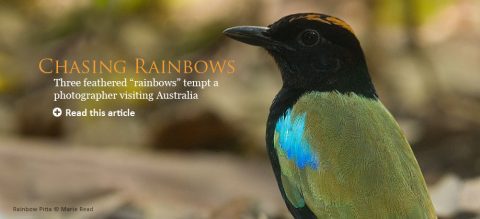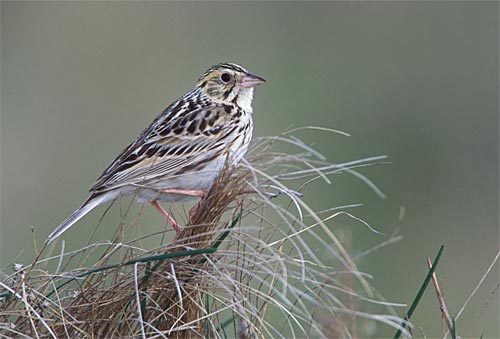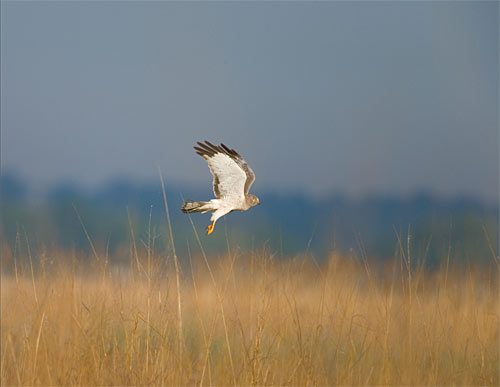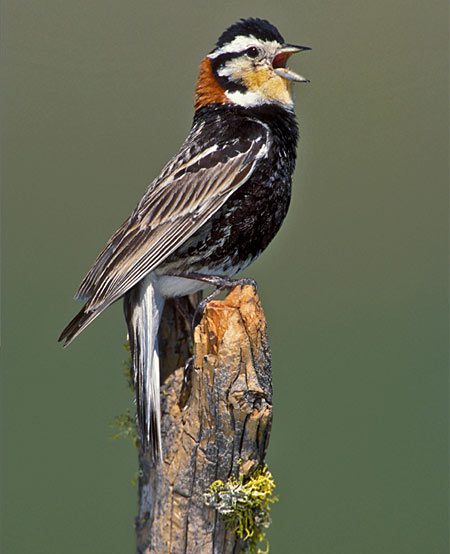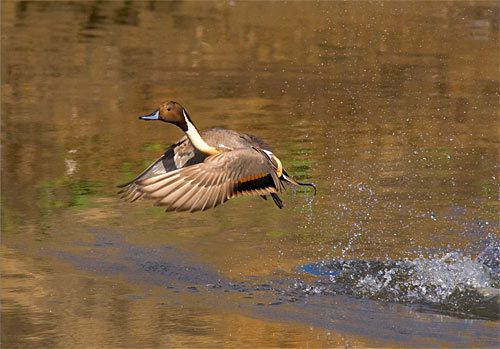With the Tribes in Montana: Manning Lake Wetlands Tribal Wildlife Refuge
by Catharine Moser
January 15, 2010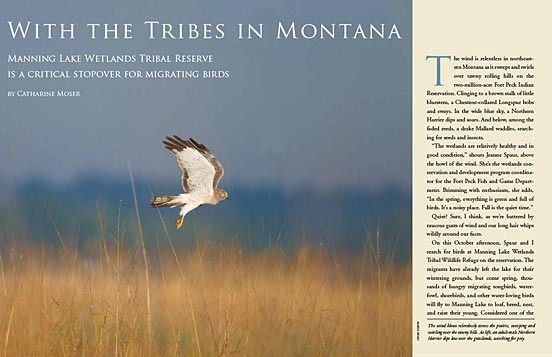
The wind is relentless in northeastern Montana as it sweeps and swirls over tawny rolling hills on the two-million-acre Fort Peck Indian Reservation. Clinging to a brown stalk of little bluestem, a Chestnut-collared Longspur bobs and sways. In the wide blue sky, a Northern Harrier dips and soars. And below, among the faded reeds, a drake Mallard waddles, searching for seeds and insects.
“The wetlands are relatively healthy and in good condition,” shouts Jeanne Spaur, above the howl of the wind. She’s the wetlands conservation and development program coordinator for the Fort Peck Fish and Game Department. Brimming with enthusiasm, she adds, “In the spring, everything is green and full of birds. It’s a noisy place. Fall is the quiet time.”
Quiet? Sure, I think, as we’re battered by raucous gusts of wind and our long hair whips wildly around our faces.
On this October afternoon, Spaur and I search for birds at Manning Lake Wetlands Tribal Wildlife Refuge on the reservation. The migrants have already left the lake for their wintering grounds, but come spring, thousands of hungry migrating songbirds, waterfowl, shorebirds, and other water-loving birds will fly to Manning Lake to loaf, breed, nest, and raise their young. Considered one of the most critical inland migratory bird stopover points in Montana, the lake is a vital avian haven featuring freshwater and saline wetlands, varying depths of open water, underwater and emergent plants, scattered potholes supporting wetlands, and miles of mixed-grass prairie. Under the spring sun, the wetlands will warm quickly and provide high-protein bird food such as midges, snails, fairy shrimp, and other invertebrates.
The refuge is one of the first of its kind. The tribes—composed of 6,000 Sioux and Assiniboine—are preserving the 4,137-acre refuge for future generations of birds as well as birders, hunters, hikers, and other outdoor enthusiasts. Of the entire 22,000-acre Manning Lake Wetlands Complex, 17,000 acres are owned by either the Fort Peck tribes or tribal members. The tribes are busy with other conservation projects such as restoring bison, Wild Turkey, and swift fox—animals native to the reservation whose populations were reduced or extirpated. These projects integrate Sioux and Assiniboine cultural and traditional values with biological management principles to protect and restore environmentally valuable sites.
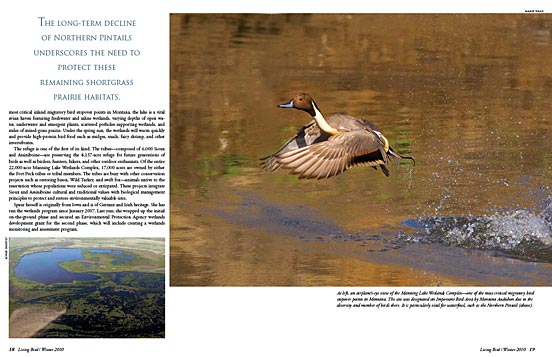
Spaur herself is originally from Iowa and is of German and Irish heritage. She has run the wetlands program since January 2007. Last year, she wrapped up the initial on-the-ground phase and secured an Environmental Protection Agency wetlands development grant for the second phase, which will include creating a wetlands monitoring and assessment program.
“The information we’ll acquire will help us in the third phase, which is restoration,” Spaur says. “We need to know the condition and health of the wetlands and associated grasslands to determine what, if anything, needs to be restored.” The program is a cooperative effort involving the U.S. Fish and Wildlife Service, Montana Native Plant Society, Montana Natural Heritage Program, and Montana Audubon.
The diversity and sheer number of birds led Montana Audubon to designate the site as an Important Bird Area (IBA). Winging their way to the refuge and surrounding area are the Chestnut-collared Longspur, Baird’s Sparrow, Sprague’s Pipit, Long-billed Curlew, Marbled Godwit, White-faced Ibis, and Franklin’s Gull—all of which are considered “at risk” due to declining population trends, threats to their habitats, or restricted distribution. “The tribes’ stewardship responsibilities are strongly felt,” says Steve Hoffman, director of Montana Audubon. “They had to approve the designation as an IBA. It is one of only a few tribal IBAs in Montana, and the tribes take great pride in having an IBA.”
Currently, the refuge bird list tops out at 37 species, but Spaur is confident the list will grow and rival other premier birding sites in Montana, including Freezeout Lake, Medicine Lake, and Bowdoin Reservoir. All are national wildlife refuges and host more than 200 bird species each.
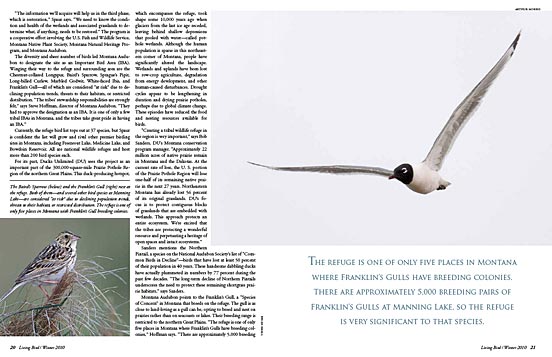
For its part, Ducks Unlimited (DU) sees the project as an important part of the 300,000-square-mile Prairie Pothole Region of the northern Great Plains. This duck-producing hotspot, which encompasses the refuge, took shape some 10,000 years ago when glaciers from the last ice age receded, leaving behind shallow depressions that pooled with water—called pothole wetlands. Although the human population is sparse in this northeastern corner of Montana, people have significantly altered the landscape. Wetlands and uplands have been lost to row-crop agriculture, degradation from energy development, and other human-caused disturbances. Drought cycles appear to be lengthening in duration and drying prairie potholes, perhaps due to global climate change. These episodes have reduced the food and nesting resources available for birds.
“Creating a tribal wildlife refuge in the region is very important,” says Bob Sanders, DU’s Montana conservation program manager. “Approximately 22 million acres of native prairie remain in Montana and the Dakotas. At the current rate of loss, the U. S. portion of the Prairie Pothole Region will lose one-half of its remaining native prairie in the next 27 years. Northeastern Montana has already lost 56 percent of its original grasslands. DU’s focus is to protect contiguous blocks of grasslands that are embedded with wetlands. This approach protects an entire ecosystem. We’re excited that the tribes are protecting a wonderful resource and perpetuating a heritage of open spaces and intact ecosystems.”
Sanders mentions the Northern Pintail, a species on the National Audubon Society’s list of “Common Birds in Decline”—birds that have lost at least 50 percent of their population in 40 years. These handsome dabbling ducks have actually plummeted in numbers by 77 percent during the past few decades. “The long-term decline of Northern Pintails underscores the need to protect these remaining shortgrass prairie habitats,” says Sanders.
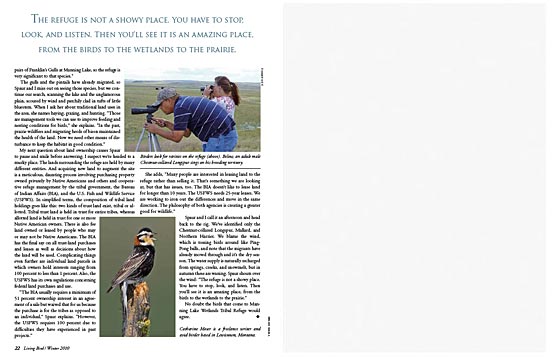
Montana Audubon points to the Franklin’s Gull, a “Species of Concern” in Montana that breeds on the refuge. The gull is as close to land-loving as a gull can be, opting to breed and nest on prairies rather than on seacoasts or lakes. Their breeding range is restricted to the northern Great Plains. “The refuge is one of only five places in Montana where Franklin’s Gulls have breeding colonies,” Hoffman says. “There are approximately 5,000 breeding pairs of Franklin’s Gulls at Manning Lake, so the refuge is very significant to that species.”
The gulls and the pintails have already migrated, so Spaur and I miss out on seeing those species, but we continue our search, scanning the lake and the unglamorous plain, scoured by wind and patchily clad in tufts of little bluestem. When I ask her about traditional land uses in the area, she names haying, grazing, and hunting. “Those are management tools we can use to improve feeding and nesting conditions for birds,” she explains. “In the past, prairie wildfires and migrating herds of bison maintained the health of the land. Now we need other means of disturbance to keep the habitat in good condition.”
My next question about land ownership causes Spaur to pause and smile before answering. I suspect we’re headed to a murky place. The lands surrounding the refuge are held by many different entities. And acquiring new land to augment the site is a meticulous, daunting process involving purchasing property owned privately by Native Americans and others and cooperative refuge management by the tribal government, the Bureau of Indian Affairs (BIA), and the U.S. Fish and Wildlife Service (USFWS). In simplified terms, the composition of tribal land holdings goes like this: two kinds of trust land exist, tribal or allotted. Tribal trust land is held in trust for entire tribes, whereas allotted land is held in trust for one or more Native American owners. There is also fee land owned or leased by people who may or may not be Native Americans. The BIA has the final say on all trust-land purchases and leases as well as decisions about how the land will be used. Complicating things even further are individual land parcels in which owners hold interests ranging from 100 percent to less than 1 percent. Also, the USFWS has its own regulations concerning federal land purchases and use.

Baird's Sparrow: one of several at-risk species found at Manning Lake. Photo by Brian Small. 
A male Northern Harrier battles Montana's relentless winds. Photo by Marie Read. 
An adult male Chestnut-collared Longspur sings on his territory. Baird's Sparrow: one of several at-risk species found at Manning Lake. Photo by Brian Small. 
Manning Lake wetlands are a critical stopover point for birds like this Northern Pintail. Photo by Marie Read.
“The BIA usually requires a minimum of 51 percent ownership interest in an agreement of a sale but waived that for us because the purchase is for the tribes as opposed to an individual,” Spaur explains. “However, the USFWS requires 100 percent due to difficulties they have experienced in past projects.”
She adds, “Many people are interested in leasing land to the refuge rather than selling it. That’s something we are looking at, but that has issues, too. The BIA doesn’t like to lease land for longer than 10 years. The USFWS needs 25-year leases. We are working to iron out the differences and move in the same direction. The philosophy of both agencies is creating a greater good for wildlife.”
Spaur and I call it an afternoon and head back to the rig. We’ve identified only the Chestnut-collared Longspur, Mallard, and Northern Harrier. We blame the wind, which is tossing birds around like Ping- Pong balls, and note that the migrants have already moved through and it’s the dry season. The water supply is naturally recharged from springs, creeks, and snowmelt, but in autumn these are waning. Spaur shouts over the wind: “The refuge is not a showy place. You have to stop, look, and listen. Then you’ll see it is an amazing place, from the birds to the wetlands to the prairie.”
No doubt the birds that come to Manning Lake Wetlands Tribal Refuge would agree.
Catharine Moser is a freelance writer and avid birder based in Lewistown, Montana.

All About Birds
is a free resource
Available for everyone,
funded by donors like you
American Kestrel by Blair Dudeck / Macaulay Library
